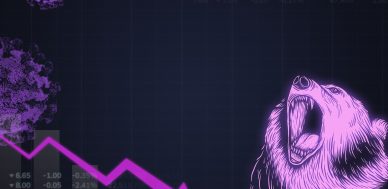This Is How a Bear Market Works
Investors sometimes forget (or don’t know in the first place) how a bear market works and end up making mistakes that hurt their portfolios. Bear markets can end careers and shake up even the most seasoned investors.
Here’s a little guide on how a bear market works and what investors can do to protect their stock portfolios. Let’s begin with the basics.
What is a bear market? It’s when a market is 20% or more below its recent high.
When does a bear market begin? Legendary investor Sir John Templeton said it perfectly: “Bull markets are born on pessimism, grow on skepticism, mature on optimism and die on euphoria.” In other words, treacherous trading begins when investors are most optimistic.
From an economic analysis point of view, bear markets begin when the economy is close to peaking or has already peaked.
How does a bear market look? See the following chart of the S&P 500 from 1999 to 2003. That was a classic bear market, one that investors can learn a lot from. If you look at the chart patterns of other bear markets, you’ll find similar characteristics.
Chart courtesy of StockCharts.com
The S&P 500 formed a top in early 2000 and really didn’t bottom until early 2003. So, the first lesson is that bear markets tend to last for some time.
Moreover while the overall trend during the bear market in the above chart was downward, in the midst of that trend, there were violent rallies. During the bear market of 2000 to 2003, the S&P 500 had at least three instances when it rallied by 20%. However, each time the market tried to run up, it was eventually met with rigorous selling.
Trading volume is worth watching as well. In a bear market, trading volume tends to increase on the days when investors ditch their stocks and tends to be relatively low when there are rallies. Since there are big rallies during a bear market, there are episodes when investor sentiment quickly turns extremely bullish and then dissipates very quickly.
From a valuation perspective, it gets tricky. During a stock market sell-off, investors might sell shares of companies that have strong fundamentals. As a bear market persists, investors become risk-averse. They’d rather get small returns for low risk than get big returns for high risk. Utilities and consumer defensive industries become two of the favorite sectors to invest in. As a bear market begins, these sectors get the most attention from investors.
When does a bear market end? For it to end, there’s usually some sort of a paradigm shift. It could be something along the lines of the Federal Reserve changing its interest-rate policy or investor sentiment improving because of some other new development. Going back to the bear market of 2000–2003, it took several months for the bottom to get in place. The S&P 500 tested the low (or came near the low) several times before it bottomed.
In a bear market, it’s generally a bad idea to try to make predictions about the bottom. Depending on the catalysts of the selling and other factors, a market can go well below what one might have thought to be a fair value.
Why Am I Talking About Bear Markets?
Dear reader, over the past few months, the stock market has taken a wild turn. If you said back in 2020 or 2021 that a bear market was inevitable, you would have been ridiculed.
I’ve warned about bear markets many times; long-term readers of Lombardi Letter can attest to this. Well, without any surprise to me, key stock indices have entered a bear market and there’s been a significant amount of selling.
We could be entering a very tricky period. If there are rallies, investors should be very careful and not get complacent. It’s important to focus on capital preservation and be extremely selective when picking stocks.
Lastly, the current bear market has several big themes behind it: the Federal Reserve raising interest rates, inflation soaring, consumer sentiment being pessimistic, and economic conditions deteriorating. For the stock market to bottom and then rebound, a lot will have to change.
